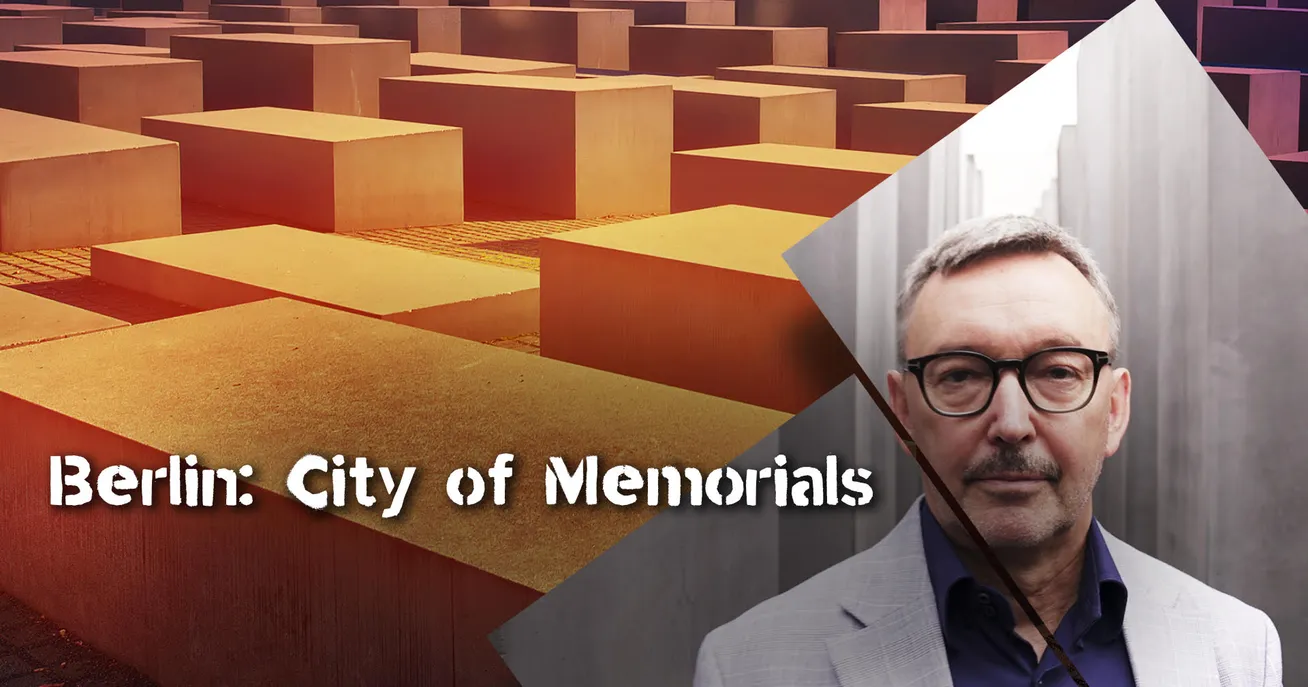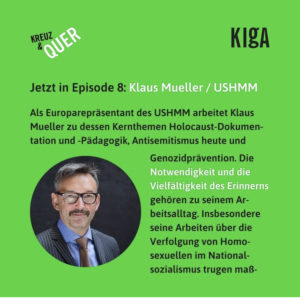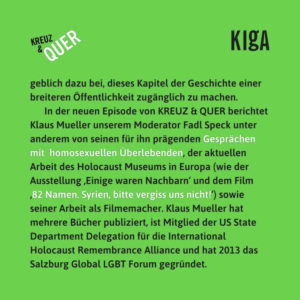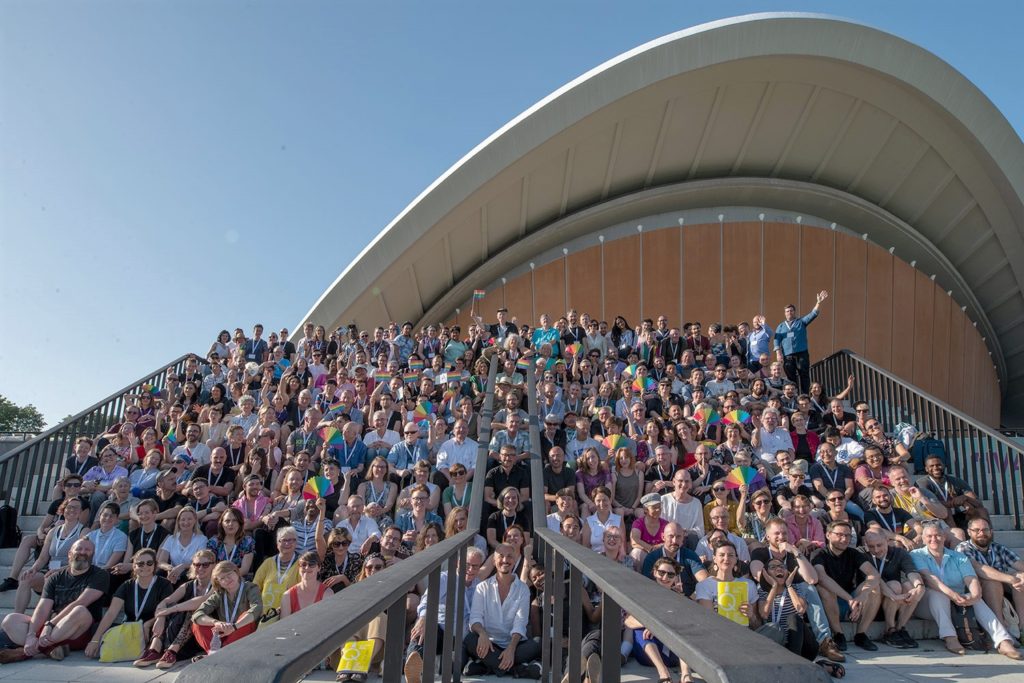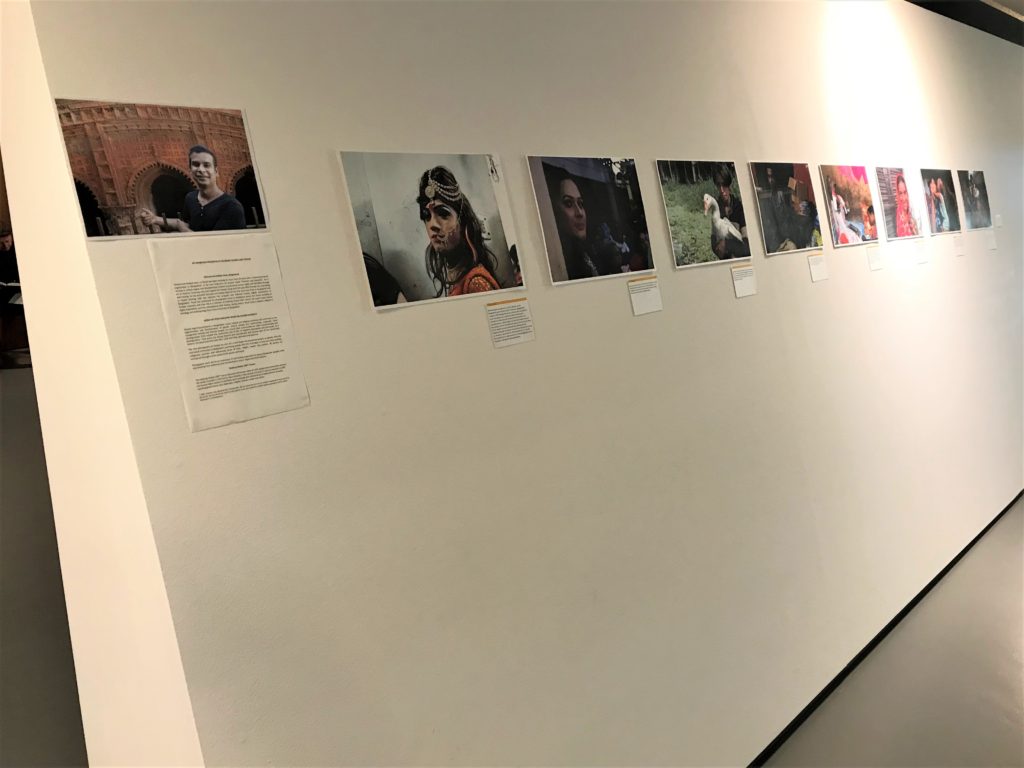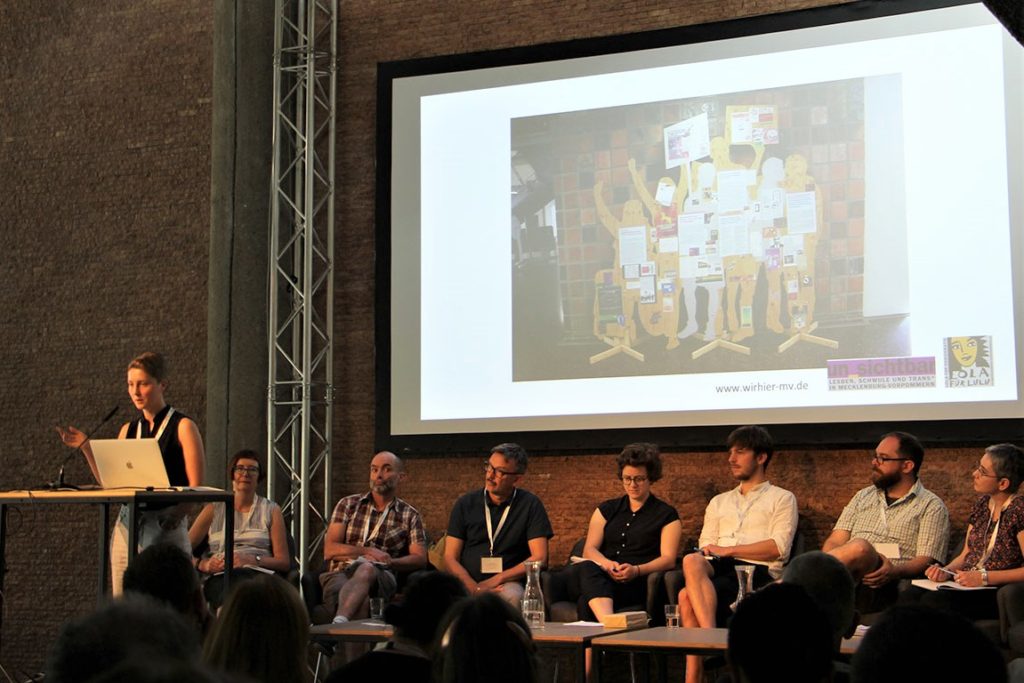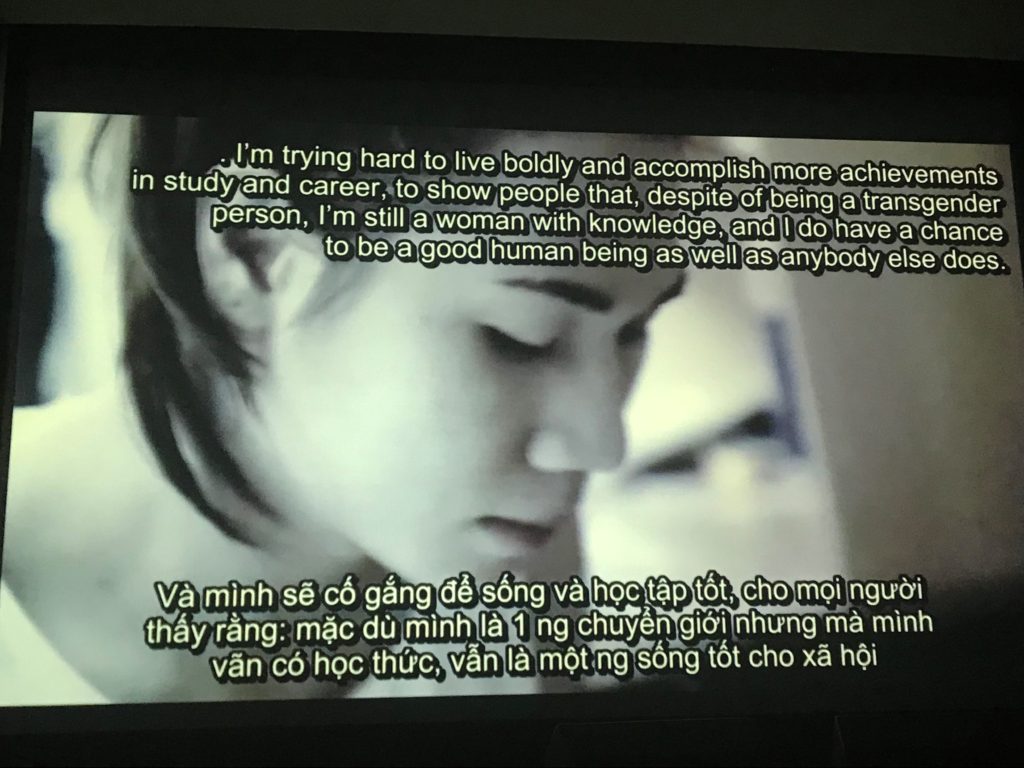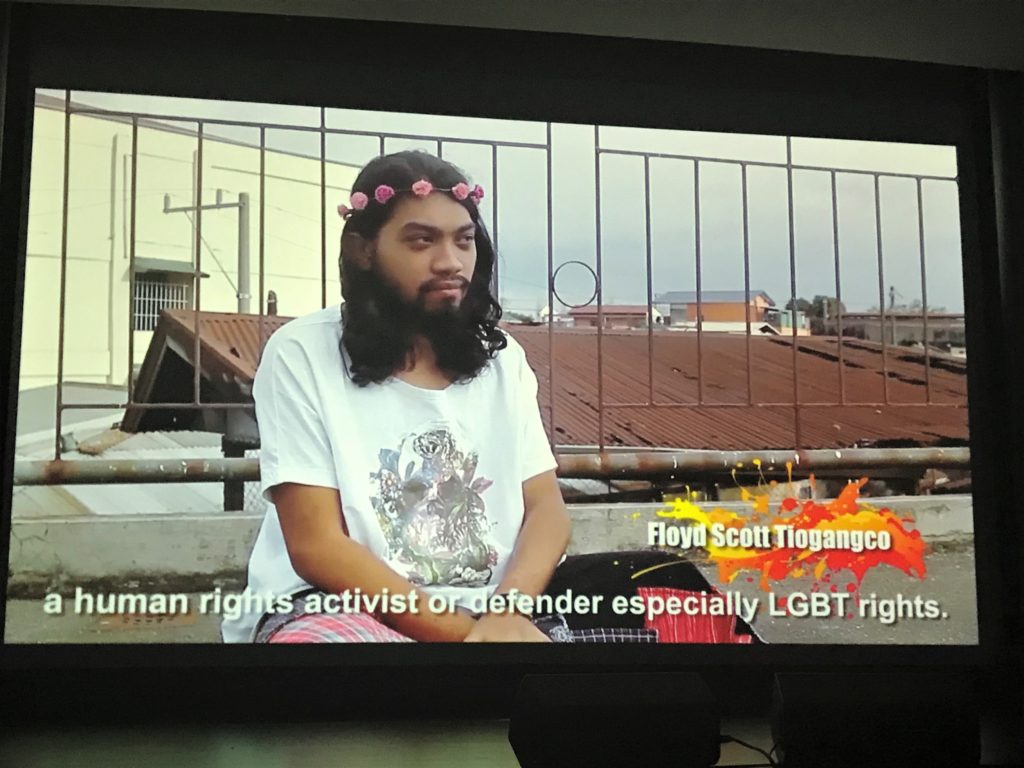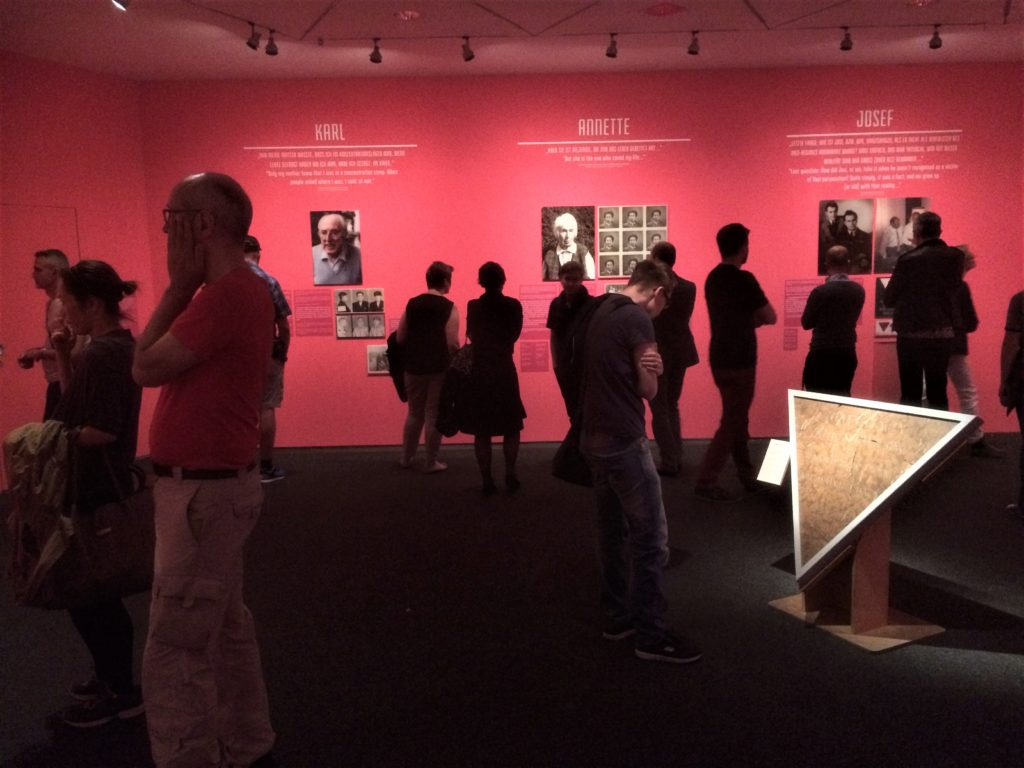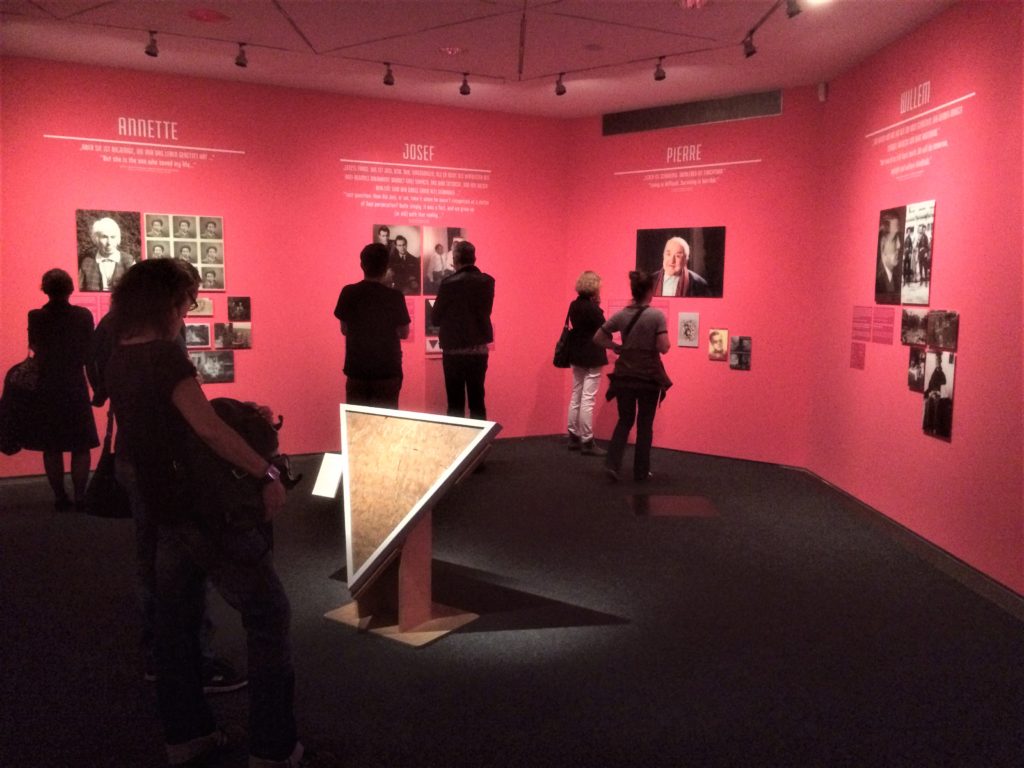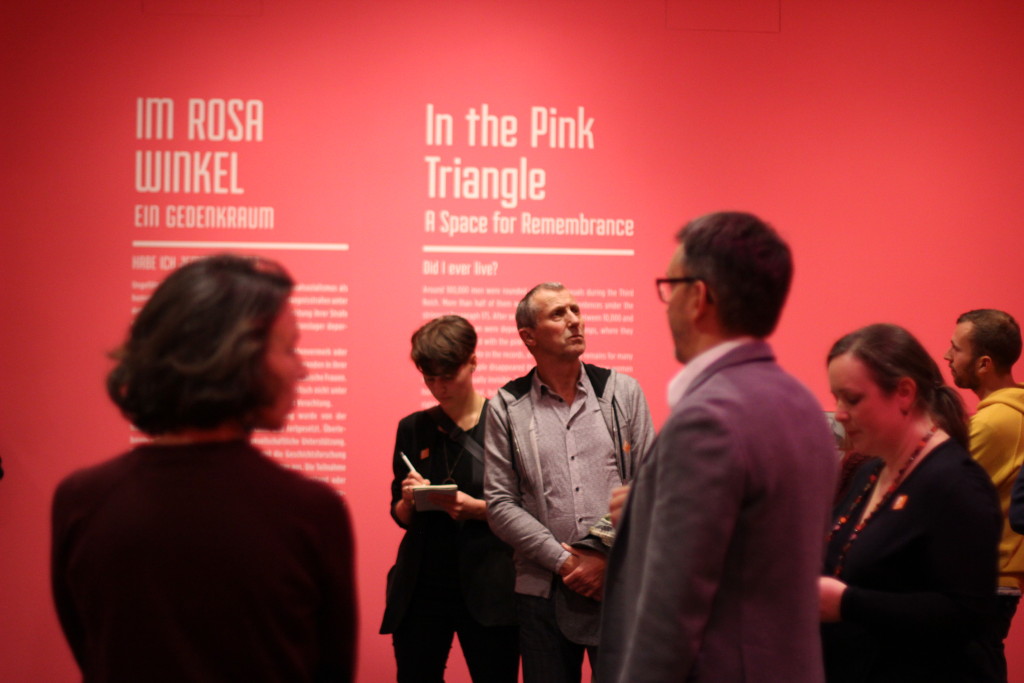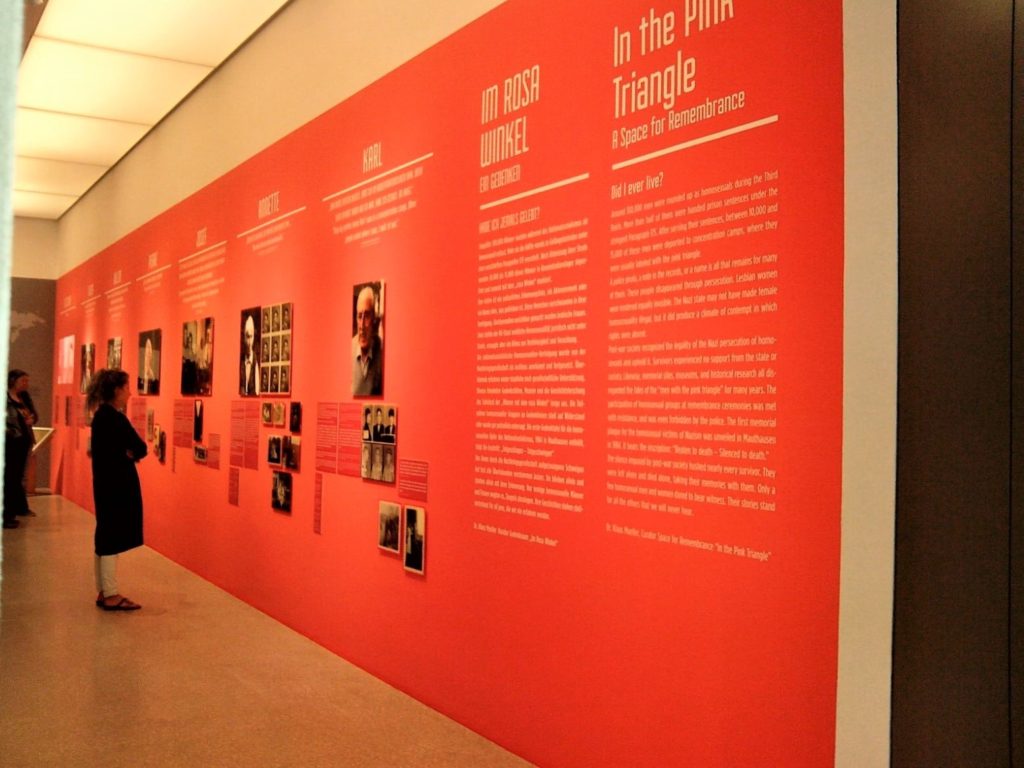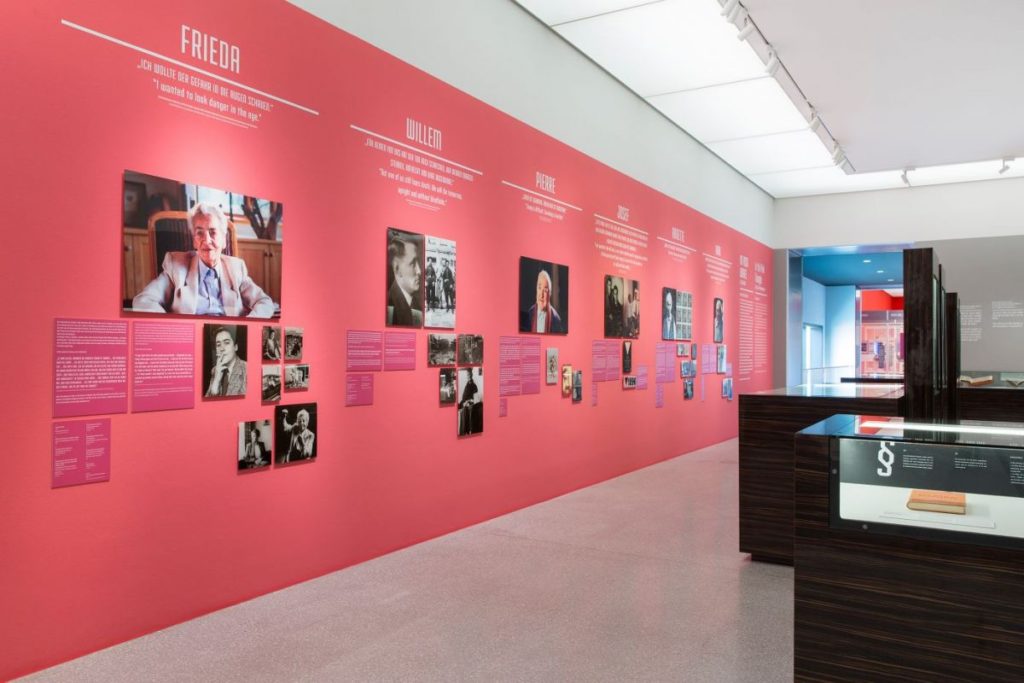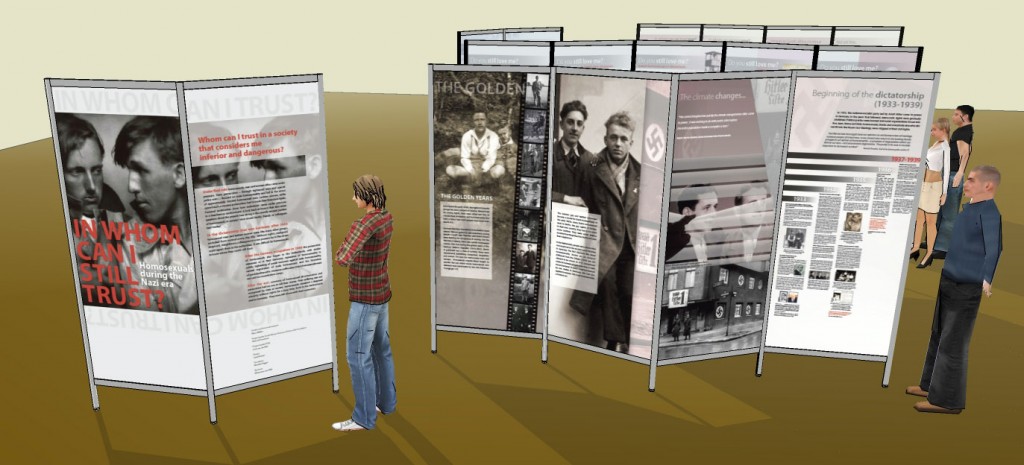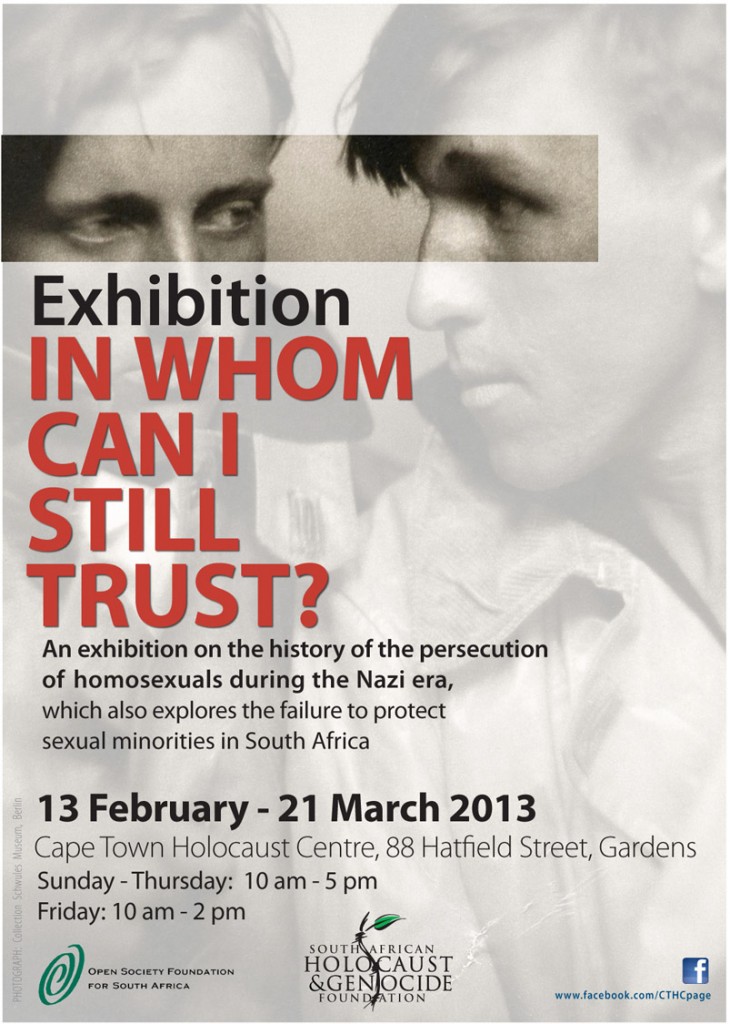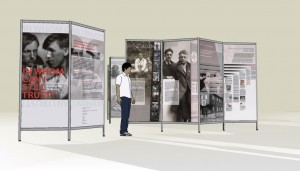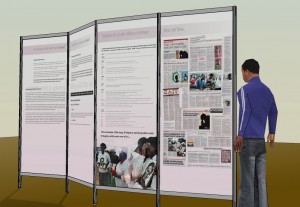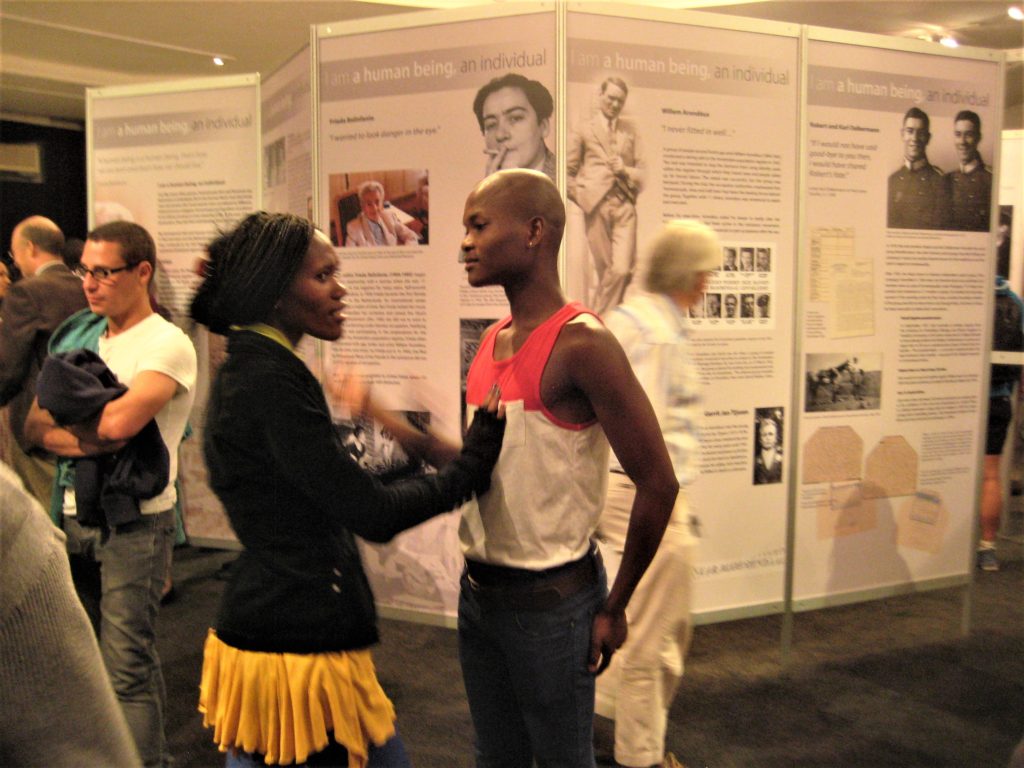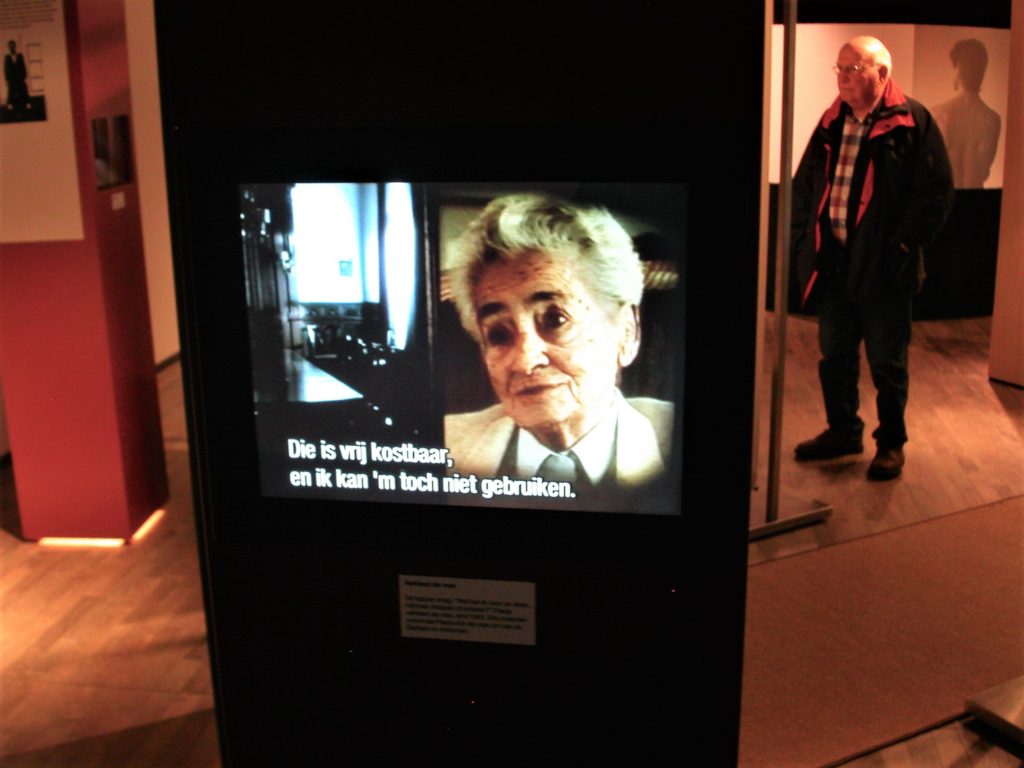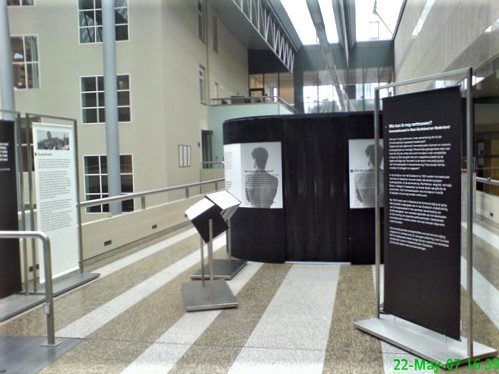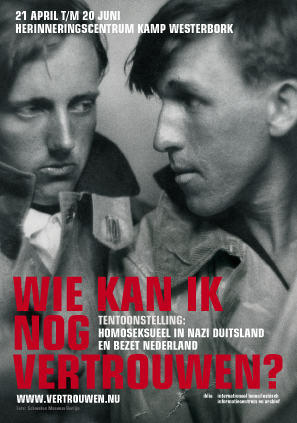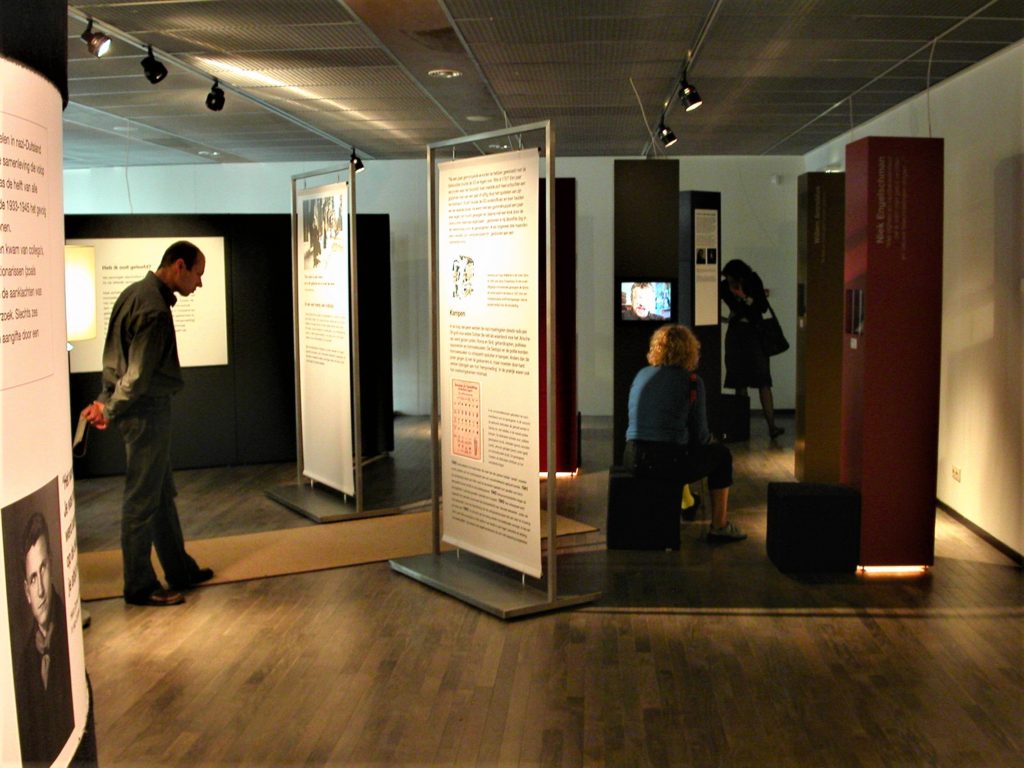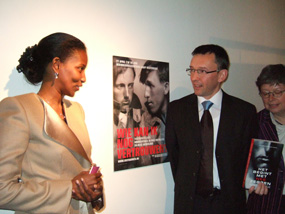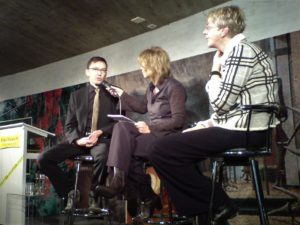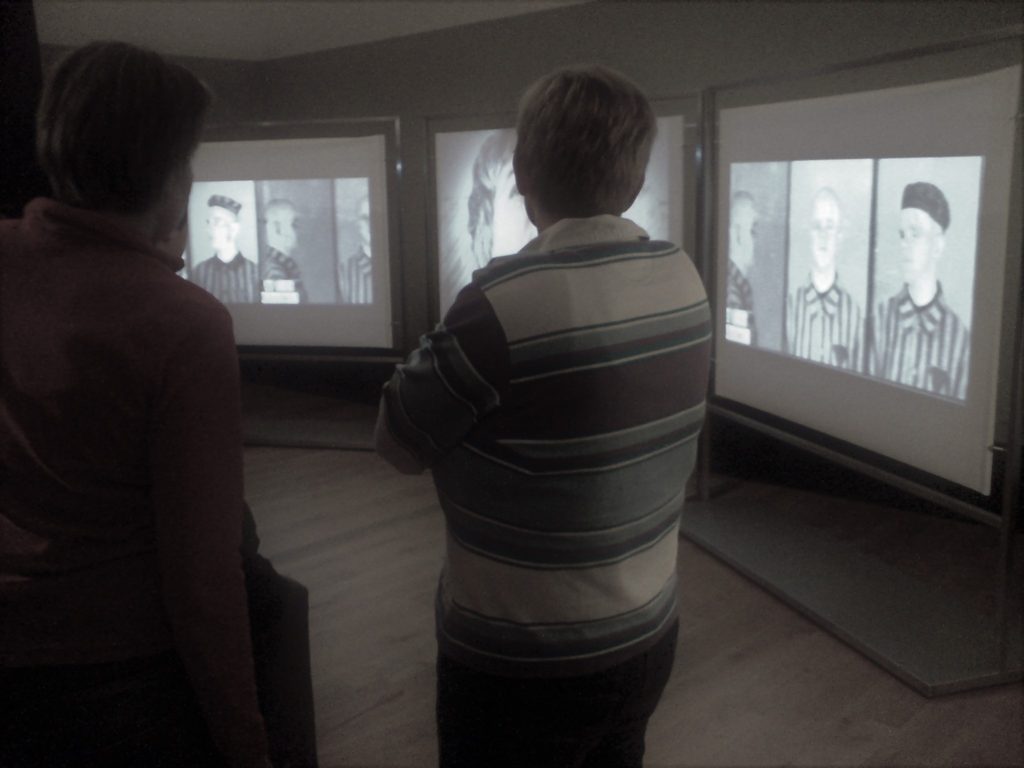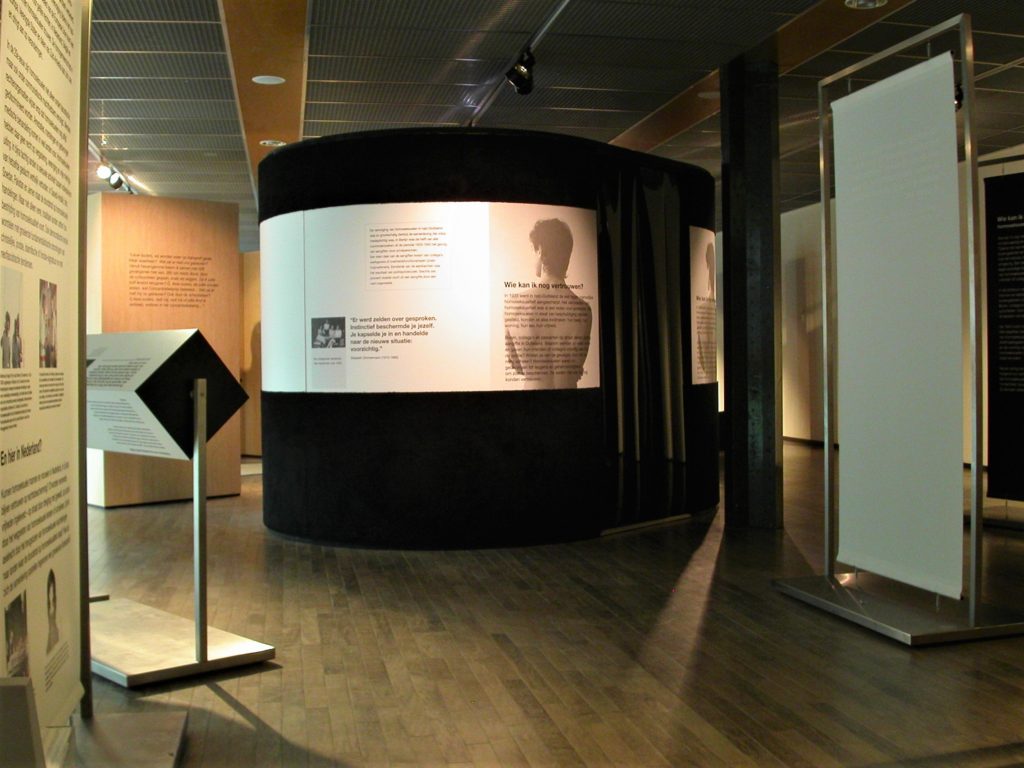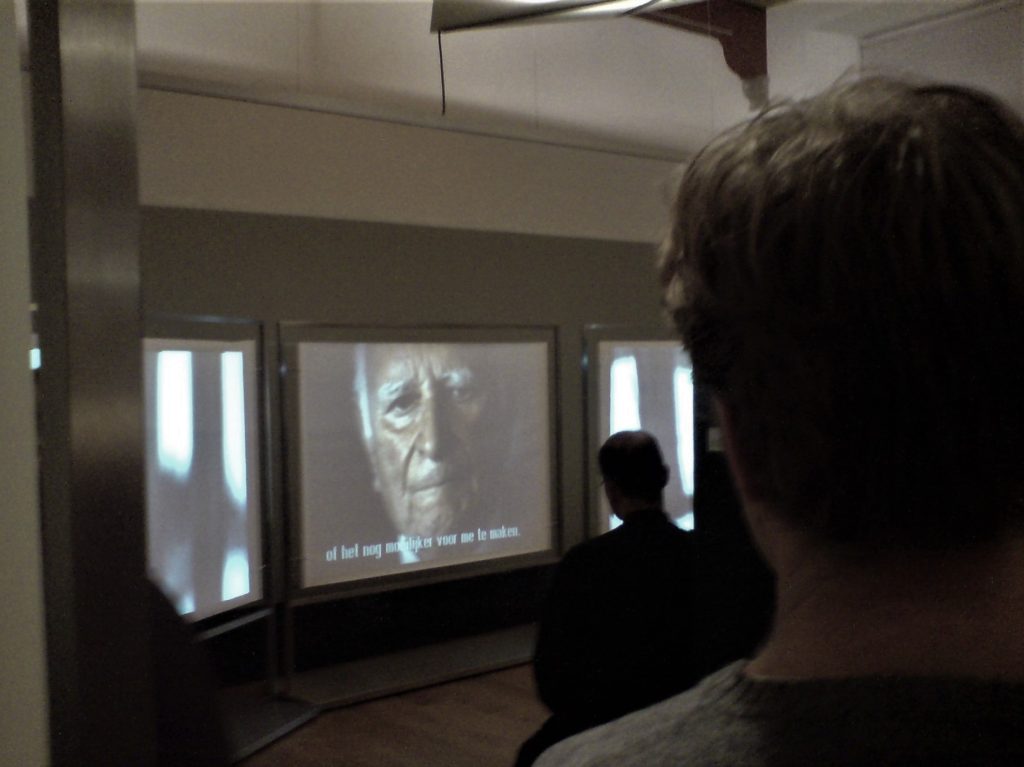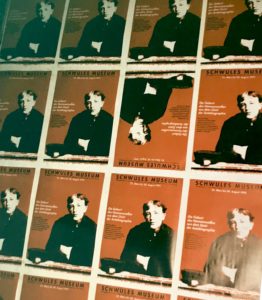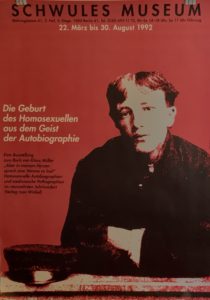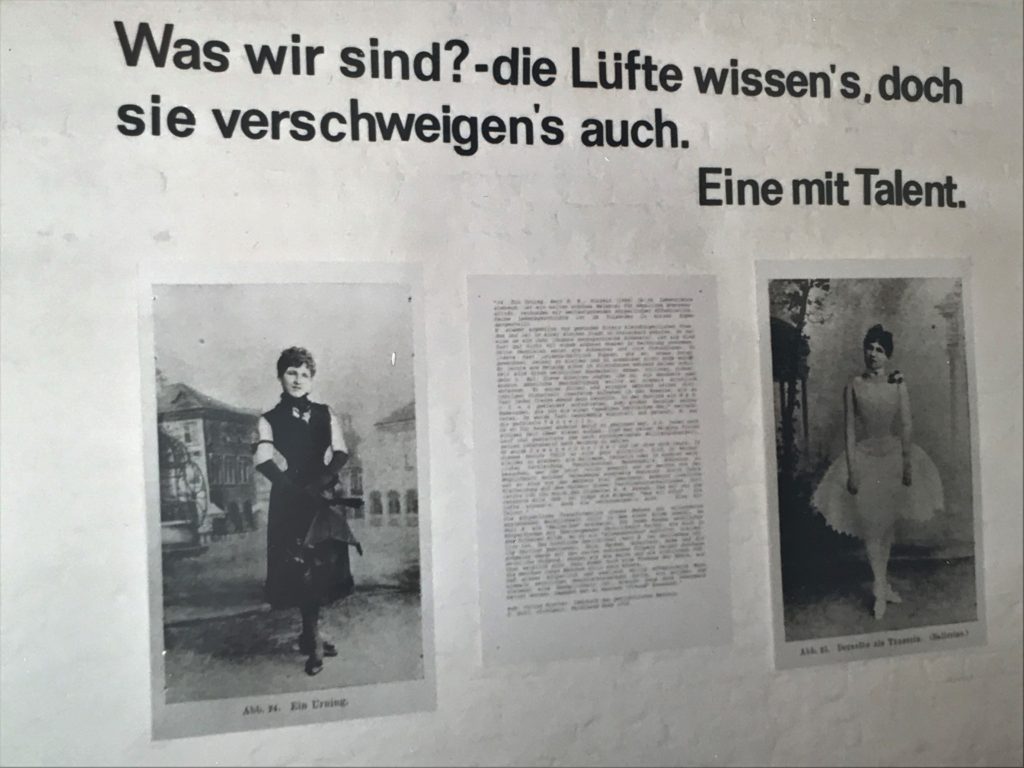[ABSTRACT: ‘The Men with the Pink Triangle: Voices lost, voices recovered’: In April 1993, the United States Holocaust Memorial Museum in Washington opened its doors on the same weekend that the March on Washington for Lesbian, Gay, and Bi Equal Rights and Liberation gathered one million LGBT people in the capital. That timely coincidence not only brought many LGBT people as visitors to the Holocaust museum on its first days: it also led to an unprecedented national discourse on gay victims of Nazi persecution — a victim group long excluded from Holocaust remembrance. In that discussion, survivor testimonies and archival records and photographs in the museum’s growing archival acquisitions took center stage. On the eve of one of the largest human rights protests in American history, they were perceived with a new public interest that raised critical and complex questions on LGBT history and present. In my article I reflect on this journey over the last 30 years. Today our remembrance is based on testimony and archival documentation that leads to new forms of remembrance and new narratives on ‘The Men with the Pink Triangle: Voices lost, voices recovered’.]
The Men with the Pink Triangle: Voices lost, voices recovered
The fragile remembrance of the destruction of the first LGBT movement worldwide
Klaus Mueller*
Representative Gerry E. Studds could hardly believe it. In April 1993, he and his colleagues from the House of Representatives visited the United States Holocaust Memorial Museum (USHMM) in Washington just days before its official opening. The museum, America’s national institution for the documentation, study, and interpretation of Holocaust history, had invited all Members of Congress to a preview. Studds had been a Massachusetts delegate since 1973 and had become one of the foremost spokesmen for the American LGBT community after coming out in 1983 as the first openly gay member of Congress.
At the entrance to the exhibition that Monday evening, Studds received a so-called identity card telling the individual story of one individual victim. The museum developed these cards with a photo and a short biography to create empathy on a personal level within the larger narrative of the Holocaust. Visitors were offered these cards upon entrance; the cards were organized by age and gender. From the hundreds of cards, Studds coincidentally received the card on Willem Arondeus, a Dutch gay resistance fighter who had led a courageous attack on the Amsterdam population register in 1943 to halt its misuse by the German occupiers to trace Jews and forced laborers. After a short German show trial, Arondeus had been executed, but he was able to ask his lawyer to testify after the war that homosexual men like him had been part of the Dutch resistance.[1] In a New York Times interview, Studds later remembered: “For me to get that card was just stunning. Of the many places we never existed, certainly the Holocaust was one, in most people’s minds. The supreme triumph in the last generation, in terms of the struggle of gay and lesbian people, is recognition of the simple fact that we exist.”[2]
In fact, Studds was so enthusiastic about this experience that he had the short biography of Arondeus included in the Congressional Records, the official documentation and historiography of the US Congress since 1789. Only members of Congress can contribute articles. In his contribution, Studds wrote that he was aware that someone like Arondeus can be quickly forgotten because his homosexuality is an almost “natural” obstacle to inclusion in collective memory. “Our memory of gay Nazi victims such as Willem Arondeus has special significance. Unlike those who were able to marry and have children, many homosexuals have died without anyone to remember them but us. We are their family and we will never forget them.”[3]
From abstraction to remembrance: survivor testimonies and archival evidence go center stage
In the early 1980’s, the Gay and Lesbian Activist Alliance had urged the Holocaust Museum to include gay victims, and the museum had decided to do so. But the search for archival documents had turned out to be difficult. Just one year before the opening of the Holocaust Museum, I was hired in 1992 as a research specialist to identify existing records in Europe for inclusion in the new permanent USHMM exhibition. Helped by my previous work on the Nazi persecution of homosexuals and a research project on homosexuality and emigration during the Holocaust, I was in contact with a broad network of gay and lesbian historians in Europe and the United States whose support was crucial. Additional archival research led me to a variety of archival repositories ranging from state archives and special collections in Gay and Lesbian Archives—such as the Gay Museum in Berlin and the archives of the Magnus Hirschfeld Society—to repositories in camp memorials across Europe and footage from filmmakers and especially private collections from survivors.
We were able in a few months to secure copies of police arrest records and photographs from Düsseldorf and mug shots of gay prisoners from Auschwitz, as well as documentation on the renowned Berlin Institute for Sexual Science, led by Dr. Magnus Hirschfeld. Pre-1933 documents and visuals from German lesbian, gay, bisexual and transgender communities illuminated their astonishing scale, diversity and reach that was already emerging at the turn of the century but fully developed in the 1920’s of the Weimar Republic. There was a growing sense of freedom in this worldwide-first LGBT community before its destruction after 1933.
Based on archival records and conversations with survivors, I prepared short biographies on individual gay men and women. The identity cards of eight gay victims and one lesbian victim traced their individual lives—their voices—and became part of the museum’s new permanent exhibition, including the card on Willem Arondeus that Congressman Studds received.
On Thursday, April 22, 1993, the United States Holocaust Memorial Museum in Washington was dedicated and started to receive its first visitors before being opened fully to the public on April 26. On the museum’s opening weekend, the March on Washington for Lesbian, Gay, and Bi Equal Rights and Liberation gathered one million LGBT people in the capital. That timely coincidence not only brought many LGBT people as visitors to the Holocaust Museum on its first days: it also led to an unprecedented national discourse on gay victims of Nazi persecution—a victim group long excluded from Holocaust remembrance. In that discussion, the museum’s growing archival acquisitions—copied archival records and photographs, original artifacts and testimonies of survivors—took center stage. On the eve of one of the largest human rights protests in American history, they were perceived with a new public interest that raised critical and complex questions on LGBT history and present.
Based on the archival evidence presented and that renewed public interest, both mainstream and LGBT media confronted in the mid-1990s in detail the most extreme persecution of LGBT people in history. For the first time, the focus turned to LGBT survivors based on their testimonies and the historical records presented in the museum’s exhibition and public programs.[4]
The pink triangle—the Nazi marking for alleged homosexual prisoners in the camps—was deeply engrained in the community’s consciousness as a symbol for the worst expression of homophobic hate and violence. For many, the triangle also was a symbol of ‘never again’, a warning of the consequences of unchecked homophobia. At the 1993 March on Washington that demanded an end to the long history of discrimination, violence and murder against LGBT people, the symbol of the pink triangle spoke loudly. During the march, speakers like Urvashi Vaid linked the opening of the museum to the larger struggle for freedom and equality: “It is fitting that the Holocaust Museum was dedicated the same weekend as this March, for not only were gay people persecuted by the Nazi state, but gay people are indebted to the struggle of the Jewish people against bigotry and intolerance.”[5]
Barrett Brick, Executive Director of the World Congress of Gay and Lesbian Jewish Organizations, stated: “We come together at a juxtaposition of events that are rightfully intertwined: the dedication of the United States Holocaust Memorial Museum, and the National March on Washington for Lesbian, Gay, and Bi Equal Rights and Liberation. The March, a clarion call for justice. The Museum, described by one writer as ‘a place of terrible beauty,’ standing as a reminder of the consequences of the failure of justice—of cowardice, indifference, appeasement, and silence, the fertile soils in which evil can flourish.”[6]
The historical solidarity Representative Studds evoked in his text became palpable. The March on Washington and the timely coincidence of the Museum’s opening finally created the possibility of confronting a complex and painful history. An extraordinary, beautiful, dignified and widely visited memorial service of gay and lesbian victims was held on April 23, 1993, close to the Holocaust Museum, filling a void and silence that had dominated post-war decades.[7]
In 1993, the museum’s approach was not just an American but an international breakthrough to document the fate of gay men who were murdered in concentration camps—a group that for nearly 50 years had been excluded from the memory of the Holocaust. The inclusive approach by USHMM was a watershed moment and opened up a new view on the multitude of archival records and the lives inscribed in them.
“Beaten to death, silenced to death”
After 1933, gay men, lesbian women, and transgender people were deeply affected by homophobic Nazi ideology and the destruction of the LGBT culture that had developed in Germany since the turn of the 19th century.
Gay men were targeted by a state-sponsored persecution under the 1935 revised Nazi version of the sodomy law, paragraph 175, that was introduced to the German Criminal Code in 1871. Historians estimate that approximately 100,000 men were arrested as alleged homosexuals. Half of them were sentenced and sent to prison. An estimated 10,000 to 15,000 of these men were deported to concentration camps, mainly in Germany and Austria. An estimated 60 percent of those men marked as alleged homosexuals were killed. Although several thousand survived, very few gay survivors dared to give testimony after the war due to ongoing persecution and legal discrimination and the lack of public empathy with their plight.
Lesbian women did not fall under paragraph 175 in Germany, while in annexed Austria, paragraph 219 did criminalize both homosexual men and lesbian women. In both countries, their meeting places were closed down, their journals forbidden, and taking part in social circles became dangerous. Although lesbian historians found only few cases of women in Nazi camp records who were deported due to being lesbian, lesbian women were deeply affected by Nazi racist propaganda to strengthen the population growth of the so-called ‘Aryan’ nation, the central role of motherhood to reach this goal, and denunciations by their neighbors or colleagues. They had to retreat into a closeted life. More research on state-instigated discrimination of lesbian women is needed.[8]
On the situation of transgender, transvestites or intersex people during the Nazi era, only first studies are available.[9] Like lesbian women and gay men, they lost their support network and partial legal protection they had established in the 1920’s. The first LGBT community worldwide that tasted a new freedom to live diverse lives, understood itself as a collective with an increasingly powerful voice, and took the liberty to expand and transgress gender roles and sexual orientations was destroyed in just a few years after Hitler’s rise to power.
How did gay survivors continue to live after 1945?
In the first decades after the end of the war, the former men with the pink triangle lacked any support network, as did lesbian women and transgender people. They received no recognition as victims of National Socialist persecution after 1945, neither by the Allies nor the subsequent two German states. The strong upsurge of homo- and transphobia in Europe in the late 1940s as well as in the United States with McCarthyism precluded public empathy with the plight of gay survivors.
Moreover, West Germany retained the National Socialist version of paragraph 175 that criminalized male homosexuality. In 1957, the West German Constitutional Court even defended this adoption of a Nazi law referencing population policies and ‘moral’ considerations, with some of the arguments closely echoing National Socialist ideas. East Germany abolished the tightened Nazi version of Paragraph 175 and went back to its previous form.
Gay men remained an easy target for denunciation. Persecution continued under the same Nazi Paragraph 175 which remained on the books in West Germany until 1969 and was only completely repealed in 1994. Between 1949 and 1969, a further estimated 100,000 gay men were charged under Paragraph 175. The German police continued to use police lists of suspected homosexual men, the so-called ‘pink lists’. Prior victims of Nazi persecution were particularly vulnerable as ‘previously convicted’ persons. German post-war history is marked not only by the lack of historical reappraisal, but this continuity of gay persecution.
Due to continuing and unchallenged discrimination and persecution after 1945 and the lack of any judicial and political recognition of the Nazi persecution of homosexuals, historians avoided the subject. Historical knowledge remained sparse due to a lack of historical research. It was not a shortage of archival records; researchers mirrored the lack of empathy for gay survivors in post-war societies and did not look into these records. The silence was not the result of shame on the part of gay survivors, but of an outspoken refusal by their families, colleagues, and the public to acknowledge them as having been persecuted unjustly. Some gay survivors went to court to seek justice and compensation, only to find former Nazi justices ruling. Memorials and committees of former prisoners excluded gay survivors from yearly remembrances and fought against memorial plaques proposed by gay and lesbian groups.[10]
Their forced silence became a topic for the first small gay and lesbian initiatives that strived to include them in Holocaust remembrance. The world’s first memorial plaque in memory of gay victims was unveiled on December 9, 1984, in the former Mauthausen concentration camp in Austria. The inscription states: “Beaten to death, silenced to death. The homosexual victims of National Socialism.”[11]
The reinterpretation of the pink triangle as a symbol of remembrance: But who do we remember?
With the development of the second LGBT movement in Germany from the late 1960’s onwards, a new generation also started to look back at the horrific past and began to ask itself: What do we know? Whom do we remember? How do we remember?
For a long time, Heinz Heger’s 1972 memoir, The Men With The Pink Triangle, was the first and only testimony and introduction to this history that historians avoided.[12] In the 1970’s, queer communities both in the United States and Europe started to adopt the Nazi invention of the pink triangle as their own symbol and code, wearing it as a sign of remembrance and linking it to contemporary discrimination. But how did gay survivors who were forced to wear a pink triangle in the camps as a sign of their dehumanization feel about this re-interpretation?
They remained invisible. Nobody asked them. The second LGBT movement in the 1970’s, after two long decades of relentless ostracizing and post-war silence, had become disconnected from their gay, lesbian, and transgender ‘grandparents’. Their story was lost, not because they did not want to share it, but because for decades after World War II, nobody wanted to hear it. In interviews I conducted with survivors, many describe this lack of empathy, this forced silence, as a second traumatization.
The pink triangle could become an international symbol of gay and lesbian pride because we were not haunted by concrete memories of those who were forced to wear them in the camps. No names, no faces; an empty memory.
The lack of research, the inaccessibility of archival documentation, and the shortage of testimonies turned gay survivors into an abstract and invisible victim group—the “men with the pink triangle”. Only in the 1990s, we began to learn more about the individuals who were deported to camps and their personal stories through rare survivor testimonies, oral history interviews, and film documentaries. Local historical research based on archival research provided for the first time more accurate documentation.[13] For the vast majority of gay survivors, however, this interest came too late. They did not witness the cautious inclusion of gay victims in memorial exhibitions that began in the 1990’s. They remained alone and died alone with their memories.
Because we did not learn more about the fate of gay victims and survivors, we easily compared their (unknown) tragedy with other forms of discrimination and persecution of queer people or to that of people with AIDS. In 1987, activists in New York City designed the powerful ‘Silence=Death’ poster campaign, using the pink triangle as a placeholder by turning it around above the key slogan, Silence = Death. Adapted by ACT UP (AIDS Coalition to Unleash Power) only months later, it became a powerful political symbol in the fight against AIDS. The poster, however, did perpetuate the usage of the pink triangle as an abstract symbol: reminiscent of the persecution conducted under the pink triangle, not of those who were forced to wear it.
Did we understand AIDS better by linking it to the Nazi persecution of homosexuals? What did we gain, or lose, by comparing AIDS with the Holocaust? There are crucial differences between the inaction and hostility of American society and politics at that time towards people with AIDS and the intentional systematic Nazi killing machine. From a gay European perspective, it seems startling eliminating these differences: we potentially minimize the distinctiveness of each event in exchange for a vague narrative of victimization.
Today, maybe due to a growing collective awareness of individual victims and their stories, the Nazi invention of the pink triangle has largely disappeared as a code and symbol of LGBT communities. It is replaced by a symbol developed by the community itself: the rainbow flag.
From Testimony over Archives to Remembrance
The exclusion of gay survivors from the memory of the Holocaust influenced their individual memories. We know that survivors need a safe space in order for them to share their story once they are ready to do that. But gay survivors had learned from their families and post-war society that their story did not matter and that made them very reluctant to be interviewed.
Over the years when I talked with them for the Holocaust Museum ID card project and later various independent film documentaries and exhibitions, they often suddenly stopped themselves telling their story because they believed “that no one is interested to hear that anyway.” It was hard for them to trust and even harder to believe that they would be acknowledged as a “survivor” and that their story was important enough to be documented in an exhibition by the Holocaust Museum.
When I let gay survivors know about the huge public interest their stories received, also due to the timely coincidence of the March on Washington and the museum’s opening, they felt recognized and heard for the first time.
Over the years, both public and media interest in the personal stories of gay survivors steadily continued and grew. USHMM public programs on the persecution of Gay and Lesbians and their role in the resistance reached a new generation that wanted to know exactly what had happened.[14] New archival acquisitions nurtured this interest. A successful $1.5 million LGBT campaign led to the acknowledgment of “American Gays & Lesbians, Families and Friends” as among the founders of the museum. Never before had the gay and lesbian community publicly contributed such large donations to a national museum. The museum travel exhibition on the Nazi Persecution of Homosexuals 1933–1945 solidified an ongoing conversation.[15]
Sometimes survivors donated artifacts that we could preserve and that now help to tell the survivor’s story through a different angle. The Holocaust Museum’s early decision and willingness to collect and provide access to archival records on the men with the pink triangle over the years has nurtured new questions and research.
From archival evidence to new narratives
Looking back, these changes seem very unlikely even in the 1990’s, and earlier even impossible. How do you build an archive when for many years there wasn’t even the need to know these facts? How do you fill an absence when even survivors themselves stopped believing that their story matters to the world? How can we rethink relevance about who deserves to be documented and understand the significance of that documentation in the face of embarrassment, active resistance, and despair?
The second traumatization of gay and lesbian survivors, however, runs deep. When I worked in the late 1990s on the film documentary ‘Paragraph 175’[16] that profiles gay survivor’s experiences based on their testimonies, they initially were still hesitant due to their disappointment from decades of indifference. Only when they saw the film did they feel vindicated and publicly embraced in a way they had never experienced before.
It was the courage and, ultimately, their willingness to share their story that guided me on these projects. Despite their hesitation to trust and their reluctance to talk, they cautiously allowed me to come into their world even when they did not fully understand why certain documents could mean so much in a museum collection, an exhibition, or a documentary film. They were men and women of their time: once they recognized the sincerity of the interest into their story, they guided me through their experiences. In the end, above all, it was their absolute need to tell their story and to be asked the questions they wanted to be asked that brought these projects to completion.[17] We owe our knowledge today to the courage and power of their testimonies. The remembrance of what happened to our generation of gay and lesbian grandparents is based on their courageous testimonies.
Research and remembrance expanded both through archival evidence becoming more accessible in this long-ignored chapter of Holocaust history. Over the next years, the Holocaust Museum acquired additional key collections relating to the Nazi persecution of homosexuals that allow recapturing the individual stories of gay and lesbian survivors:
- Collection Josef Kohout / Heinz Heger. – Heinz Heger’s The Men with the Pink Triangle (republished in English in 1994) had an enormous reach for past and new generations as the long-time only gay survivor testimony. Heger, a pseudonym for Josef Kohout, never learned how much he had changed history with his testimony that was published in 1972 by a small German publisher house (after years of searching a publisher). Today his testimony has been translated into all major European languages, as well as Japanese. In 1995, I met with Kohout’s long-term partner Wilhelm Kröpfl and learned the full story of how Kohout’s memoir came into being. Kröpfl donated a unique collection of records documenting Kohout’s story to USHMM Archives, including letters by his parents during his years in the camp system; notes by Kohout during liberation and his pink triangle. The collection also helped to validate Kohout’s achievement.[18]
- Collection Pierre Seel. – In 1994 French survivor Pierre Seel published his memoir “Moi, Pierre Seel, déporté homosexuel”. He found the courage to testify after hearing excerpts from Heinz Heger’s testimony during a reading. At the age of 17, Pierre Seel was arrested for alleged homosexuality and imprisoned in Schirmeck-Vorbrück internment camp. After his release, being traumatized by his experiences, his family forbade him to talk about his time in the camp. But his mother, at the end of her life, revealed to him a small object—a Mickey Mouse doll surrounded by the garland from her wedding veil—which she had made while he was in the camp. As Pierre shared with me, this artifact was a late revelation that his mother had prayed for his survival and return. In 2001 Pierre Seel entrusted this special object to the Museum.[19]
- Collection Frieda Belinfante. – A talented cellist educated by her Jewish father, one of the first female conductors in music history, a lesbian member of the Dutch resistance: The lives of Frieda Belinfante stretch over nine decades of the 20th century. Frieda was born on May 10, 1904, in Amsterdam and died on April 26, 1995, in Santa Fe, New Mexico.
Frieda became the first female conductor in prewar Amsterdam but retreated from a promising musical career after the German invasion of the Netherlands. She dissolved her orchestra and went underground, first working alone falsifying ID cards for Jews in hiding, later with gay writer Willem Arondeus (see above). Both participated in the preparations of the attack on the Amsterdam population registry in 1943. Frieda survived as one of the few members of the group, for months hiding in men’s clothing. On her own, she escaped via Belgium and France to Switzerland in the winter of 1944 and was interned in a Swiss refugee camp. After the war she returned to the Netherlands and emigrated to the United States in 1947. She founded the Orange County Philharmonic Orchestra in the early 1950’s and was its conductor for many years.
In May 1994, I had the unique chance to interview then 90-year-old Frieda Belinfante for the Holocaust Museum. The eight-and-a-half-hour interview, conducted over two days, became part of the Museum’s Oral History collection. During the hours of conversations, a special bond of trust developed between us, and Frieda shared her full story. She allowed me to ask honest questions about her life, willing to share her experience as a lesbian woman openly for the first time. A sense of recognition that we both were gay and had lived in the same neighborhood in Amsterdam connected us. Research based on her detailed testimony unearthed additional material on her work in the resistance, her escape to Switzerland in 1944, her emigration and successful career in the United States and allowed us to copy close to 100 photos documenting her life.[20]
I continued working on Frieda’s story in a documentary film, a biographical portrait, several exhibitions, and lectures. In 2021, I was honored to pay tribute to Lesbians and Gay men in the resistance with a special feature on Frieda in a USHMM Facebook Live Event called ‘Pride Month: Defying Nazi Persecution’.
- Collection Gad Beck. – Gad Beck and I met many times in which he shared his story of survival in Nazi Berlin while we walked through Berlin of today. Nearly sixty years after his friend and lover Manfred Lewin presented him with the gift of a small self-made booklet with poems and illustrations as a sign of their love, Gad Beck entrusted me with this fragile and intimate artifact as a gift for the Holocaust Museum’s collection. Eager to make this small booklet accessible to a larger audience, we decided to capture its story in the museum’s first exclusively online exhibition, Do you remember when. Telling the story of Gad and Manfred, it became evident how the meaning of this artifact was changed by Manfred’s deportation and death in Auschwitz and the passing years. The booklet, once only meaningful for Gad and Manfred, became a time capsule, a reminder of a friendship, of the daily life of Jewish youth group in Berlin in 1941/42, and of the events that destroyed most of them. The online exhibition Do you remember when narrates their story and that of their families and friends.[21]
- German Court, Police, Gestapo, and camp records. – German Court, Police, Gestapo, and camp records collections copied over the years (such as the General State Prosecutors Office of the State Court of Berlin records; the Duesseldorf police records; the Gestapo collection from Wurzburg) as well as records from across Europe open the potential of new research.
Records that were created as part of a process to oppress, torture, and dehumanize LGBT people today have become documents of their humanity in a situation of peril. The evidence gathered against them often contains private correspondences, forced testimonies, or denunciations by their neighbors or colleagues. This ‘evidence’ today enables us to reconstruct parts of their lives and voices. The police and camp mugshots taken of them in order to take away their individuality and humanity today remind us of the human beings they were.
- Oral History interviews. – Oral history interviews with gay survivors are scarce and will remain scarce. The USHMM Oral History Collection holds three interviews I conducted with gay survivors, one with lesbian Frieda Belinfante about her work in the Dutch resistance, and one with a Jewish-gay emigrant.[22] An equally small number of gay survivor interviews is part of the USC Shoah Foundation’s Visual History Archive, some interviews with Jewish survivors provide additional information on fellow gay inmates.
Independent documentary films have added to this small number. Wir hatten einen grosses A am Bein (“We were marked with a big ‘A'”) by Joseph Weishaupt and Elke Jeanrond was based on three interviews with gay survivors in 1991. Based on my conversations with gay survivors, I developed the idea of the documentary film Paragraph 175 (USA 2000) for which I interviewed five gay survivors. The film, a collaboration with American directors Rob Epstein and Jeffrey Friedman, had its American premiere at the Sundance Film Festival and its European premiere at the Berlin film festival over the years reached a large global audience.
Today, the Holocaust Museum lists hundreds of collections containing partial information on the Nazi persecution of the LGBT community in Germany and German-occupied Europe. Information on these collections is accessible online, as are many photographs, artifacts, or interviews.
The power of testimonies, artefacts, and archival documents opens the potential to approach them from different perspectives, to look at them with new questions, and to realize connections to larger questions. As each generation explores its own questions looking back, archives can be powerful repositories. Over the years, some of the LGBT-related collections at the museum have generated strong interest and been presented in new curatorial and narrative features.[23]
The future of memory of the first LGBT movement worldwide
Archival evidence remains a fundamental resource for future research to fill the many gaps that remain. The growing accessibility of documents on the Nazi persecution of LGBT people and communities is especially important given the decades-long silence. Homosexual victims often were not publicly remembered by their families. Karl Gorath’s mother was so ashamed of her son being incarcerated in camps for many years due to paragraph 175 that she told everyone he had served in the German army. Pierre Seel’s family and children cut all connections with him when he published his memoir. Josef Kohout’s family did not partake in his struggle with Austrian authorities to be recognized as a victim of the Nazi regime. Frieda Belinfante’s family did not attempt to honor her contribution to the Dutch resistance. Gay survivors I interviewed all emphasized that ‘nobody wanted to hear their story’, neither their families nor their gay or lesbian friends who were engulfed, struggling with the oppressive post-war discrimination and persecution.
In regard to gay victims of the Nazi regime, we depend on archival records to reconstruct their story. The growing inclusion of gay victims in many Holocaust memorials started cautiously in the 1990s and is based on the power of testimonies, archival evidence, and historical research. 75 years after the end of the war, the fate of LGBT victims has become a focus of specified historical research, mostly by LGBT historians. While publications in this field have produced vital new historical knowledge, mainstream historiography often tends to disregard their relevance to analyze the many layers of Nazi doctrine and policies. Many questions still remain open, especially on the collaboration and complicity of non-state actors. This includes the Christian churches as well as by ordinary citizens: denouncing their fellow colleagues, their friends, or even their family members to the police and Gestapo as gay or lesbian set a machine in motion that for many would become deadly.
Future research will explore new questions as more archival records, once classified or restricted, are becoming accessible. While archival study often is conducted regionally, the research on the Nazi persecution of homosexuals has transnational relevance.[24] Increasingly, comparative research across borders is possible, leading to new research fields.
“We lacked the moral support and sympathy of the public”
In 1995—for the first and only time—a group of gay survivors issued a collective declaration 50 years after their liberation demanding recognition. Nazi persecution and post-war silence had individualized and fragmented their persecution: in interviews, survivors rarely claimed a sense of a collective voice as they never felt part of such a collective. I had worked with them on drafting the declaration which was published on May 29, 1995 during a program I developed for the Holocaust Museum. Eight gay survivors from four countries—Germany, France, Poland, and the Netherlands—signed. The declaration was widely reported upon, including in the New York Times.[25]
They started the declaration with these lines:
50 years ago, Allied troops did liberate us from Nazi concentration camps and prisons. But the world we had hoped for did not happen to come true.
We were forced to hide again and faced on-going persecution under the same Nazi-law that was on the books since 1935 and stayed on the books until 1969. Raids were frequent. Some of us – just tasting their new freedom – were even sentenced to long-term prison again.
Although some of us tried courageously to gain recognition by challenging the courts up to the West German Supreme Court, we were never acknowledged as being persecuted by the Nazi regime. We were excluded from financial compensations for the victims of the Nazi regime. We lacked the moral support and sympathy of the public.
Hearing their voices, narrating their stories based on archival evidence, preserving the few private collections that were not lost or destroyed as irrelevant or shameful by their families, has changed how we remember the men with the pink triangle: as people in their own right, as individuals, as human beings.
The future of memory of the men with the pink triangle and of the first LGBT movement worldwide will be defined by how each new generation develops its own questions and find new ways to narrate this darkest chapter of LGBT history.[26]
*Based in Berlin, Dr. Klaus Mueller works as an international consultant for a number of cultural institutions, including the United States Holocaust Memorial Museum in Washington DC for which he serves as the Museum’s Representative for Europe. During the conception of the Museum’s permanent exhibition, Dr. Mueller, an expert on the Nazi persecution of homosexuals, served as a consultant, researching and contributing to the inclusion of records documenting the experiences of homosexuals under Nazism. The opinions expressed in this article are the author’s and do not necessarily reflect the opinions of the United States Holocaust Memorial Council or the United States Holocaust Memorial Museum.
[1] Compare Klaus Mueller: ‘Het is zoo licht om in liefde van het leven te scheiden’. Willem Arondéus, homoseksueel verzetsleider. In: Klaus Mueller en Judith Schuyf (Ed.): Het begint met nee zeggen. Biografieën rond verzet en homoseksualiteit 1940-194. Amsterdam, Schorer 2006. Compare also: Jan Rogier, ‘Lau Mazirel: “Ze hadden me gevraagd solidair te zijn”’, in: Seq, December 1970 nr. 8, pp. 13-18; Also published in Vrij Nederland, December 19, 1970; Marco Entrop, Onbekwaam in het compromis. Willem Arondéus, kunstenaar en verzetsstrijder. Amsterdam 1993; Rudi van Dantzig, Het leven van Willem Arondéus, 1890-1943. Een documentaire. Amsterdam 2003.
[2] Compare interview in David Dunlap, ‘Personalizing Nazis’ homosexual victims’, in: New York Times, June 26, 1995.
[3] Gerry E. Studds text ‘Remembering Gay Victims of the Holocaust’ was entered into the Congressional Records on April 21, 1993. A copy can be found here. http://www.onearchives.org/wp-content/uploads/2015/02/Remembering-Gay-Victims-of-the-Holocaust-by-Gerry-Studds-April-21-1993.pdf
[4] Compare: Hertum van, Aras: Museum rediscovering the ‘forgotten victims’ of Nazis. In: Washington Blade, No. 37, Vol. 23, 1992; Hart, Sara: “A Dark Past Revealed,” 10 Percent [San Francisco], vol. 1, no. 5 (Winter 1993): 37-39, 74; Hertum van, Aras: Survivors of Nazi camps begin to tell their stories. In: Washington Blade, No. 18, Vol. 24, 1993; Mueller, Klaus: A difficult relationship. In: Washington Jewish Week, April 22, 1993; Rios, Delia: Telling Story of Nazi persecution of gays. In: The Plain Dealer, May 15, 1993; Rose, Rick: Museum of Pain. In: The Advocate, Issue 628, May 4, 1993; Mueller, Klaus: The Holocaust # Aids. In: The Advocate, Issue 628, May 4, 1993; E.J.Dionne Jr: The Austin Vote: It’s not all bigotry. In Washington Post, May 10, 1994; Englehart, Rachel: Films show Nazi war against gays. In San Francisco Examiner, May 14, 1994; Weinraub, Judith: “Trials of the Pink Triangle: Historian Klaus Müller, Documenting the Nazi Torment of Gays,” Washington Post (June 6, 1994): pp. D1, D4; Los Angeles Times interview Klaus Muller: Documenting Gay Life Under Nazis for Holocaust Museum and History, December 4, 1994 by Michael Bronski; Holland, Darrell: Museum visit a window on a time of hatred. In: The Plain Dealer, November 6, 1994; Dunlap, David W: “Personalizing Nazis’ Homosexual Victims,” New York Times (June 26, 1995): pp. A1, B4; Linenthal, Edward T.: The Boundaries of Memory: The United States Holocaust Memorial Museum. In: American Quarterly, Vol. 46, No. 3. (Sep., 1994), pp. 406-433; Linenthal, Edward T.: Preserving Memory. The struggle to create America’s Holocaust Museum. New York, Viking Pinguin 1995 (see pages 187-189); Interview with Wolf Blitzer, CNN, Gay Jewish survivor of Nazi Germany says he was never unlucky, May 5, 2000.
[5] Urvashi Vaid spoke on April 25, 1993 at the March on Washington.” It is fitting that the Holocaust Museum was dedicated the same weekend as this March, for not only were gay people persecuted by the Nazi state, but gay people are indebted to the struggle of the Jewish people against bigotry and intolerance. It is fitting that the NAACP marches with us, that feminist leaders march with us, because we are indebted to those movements.” https://www.cs.cmu.edu/afs/cs/user/scotts/bulgarians/vaid-mow.html
[6] Barrett Brick full speech can be found here: http://www.glaa.org/archive/1993/brickushmm0423.shtml.
[7] Please compare: Linenthal, Edward T.: The Boundaries of Memory: The United States Holocaust Memorial Museum. In: American Quarterly, Vol. 46, No. 3. (Sep., 1994), pp. 406-433. See p. 419. Compare also: Klaus Mueller: Whom do we remember?, Candlelight vigil in remembrance of gay and lesbian victims of the Holocaust, Washington DC, Apr 23, 1993.
[8] Compare Claudia Schoppmann: Nationalsozialistische Sexualpolitik und weibliche Homosexualität, Pfaffenweiler 1991; Claudia Schoppmann (Ed.): Im Fluchtgepäck die Sprache, Berlin 1991; Ilse Kokula / Ulrike Boehmer: Die Welt gehört uns doch!, Zürich 1991; Claudia Schoppmann: Days of Masquerade: Life Stories of Lesbians During the Third Reich, New York 1996; Christa Schikorra: Kontinuitäten der Ausgrenzung. „Asoziale“ Häftlinge im Frauen-Konzentrationslager Ravensbrück, Berlin 2001; Andreas Brunner, Ines Rieder, Nadja Schefzig, Hannes Sulzenbacher, Niko Wahl: geheimsache: leben – Schwule und Lesben im Wien des 20. Jahrhunderts, Wien 2005; Joachim Müller: Vergleichbarkeit der Lebenssituation lesbischer Frauen mit der Lebenssituation schwuler Männer im Nationalsozialismus (und nach 1945), Berlin 2007.
[9] Rainer Herrn describes the state of research in: Rainer Herrn: In der heutigen Staatsführung kann es nicht angehen, daß sich Männer in Frauenkleidung frei auf der Straße bewegen. Über den Forschungsstand zum Transvestitismus in der NS-Zeit. In: Michael Schwartz: Homosexuelle im Nationalsozialismus. München 2014.
[10] Compare Der Gedenkstein in Neuengamme. Eine Dokumentation der Unabhängigen Homosexuellen Alternative, Hamburg 1985; Klaus Mueller: Amnesien. Formen des Vergessens, Formen des Erinnerns, in: Der homosexuellen Opfer gedenken. Hg. von der Heinrich-Böll-Stiftung, Berlin 1999, p. 56-69; Susanne zur Nieden: Er ist 175 (warmer Bruder). Ausgrenzungen verfolgter Homosexueller in Berlin 1945-1949, in: Joachim Müller, Andreas Sternweiler 2000, S. 338-351; Wolfgang Benz: Im Schatten des Holocaust, in: Jellonek/Lautmann 2002, S. 27-40 (especially p. 35-38 about the memorial stone in Dachau)
[11] Compare also: Klaus Mueller: Totgeschlagen, totgeschwiegen? Das autobiographische Zeugnis homosexueller Ueberlebender. In: Jellonek/Lautmann 2002, S. 397-418. Gay memorial plaques, stones or sculptures were placed at the site of former camps in Mauthausen (1984), Neuengamme (1985), Dachau (1987), Sachsenhausen (1992), Buchenwald (2002), Risiera San Sabba, Trieste (2005). Memorials outside the site of former concentration camps: Amsterdam (1987), Nollendorfplatz, Berlin (1989), Bologna (1990), The Hague (1993), Frankfurt (1994), Cologne (1995), Anchorage, Alaska (1999), San Francisco (1999), Rome (2000), Sydney (2001), Laxton, Great Britain (2005), Montevideo, Uruguay (2005), Vienna (2007) and Barcelona (2011). So far, around 90 stumbling blocks – in a Europe-wide project by artist Gunter Demnig (who has been commemorating the victims of the Nazi era since 2000 by placing brass memorial plaques on the sidewalk in front of their last place of residence) remind of the individual fates of persecuted homosexuals across Europe.
[12] Martin Sherman’s 1979 play Bent used Heger’s testimony and was the first theater play on the topic.
[13] A few earlier, yet tremendously important publications presented archival records for the first time, most notable: Wolfgang Harthausen: Der Massenmord an Homosexuellen im Dritten Reich, in: W. Schlegel (ed.): Das große Tabu. Zeugnisse und Dokumente zum Problem der Homosexualität, München 1967; Harry Schulze-Wilde: Das Schicksal der Verfemten. Die Verfolgung der Homosexuellen im Dritten Reich und ihre Stellung in der heutigen Gesellschaft, Tübingen 1969; Rüdiger Lautmann, Winfried Grikschat and Egbert Schmidt: Der rosa Winkel in den nationalsozialistischen Konzentrationslagern, in: Lautmann, Rüdiger: Seminar: Gesellschaft und Homosexualität, Frankfurt/M 1977; – Hans-Georg Stümke und Rudi Finkler: Rosa Listen, rosa Winkel, Reinbek 1981; – Richard Plant: The pink triangle. The Nazi war against homosexuals, New York 1986.
[14] The USHMM Public Programs and diverse lectures I conducted between 1993-2000 on homosexual life during the Nazi era reached large audiences and contributed to conversations LGBT communities were developing on this subject. Lecture: The exclusion of gay victims in Holocaust Memorial Culture, Opening Conference USHMM Holocaust Research Institute 1993; – Public Program: ‘We were marked with a big A’, Dec. 12, 1993, USHMM; Public Program and film series: Stories untold: Gays and Lesbians during the Holocaust, USHMM, May 15-19, 1994; – Lecture: Making history invisible. The exclusion of gays in Holocaust memorials as an example of representational problems of the so-called forgotten victims, Conference Memorials and Museums on the heritage of the Nazi past and the Holocaust in the United States and Germany: Similarities and Differences, USHMM, Sep 1994; – Lecture: The persecution of gay men in Nazi Germany and its relevance to contemporary politics concerns, Lesbian and Gay Congressional Staff Association, Oct. 18, 1994; – Film program: ‘Survivors – Stories from the Holocaust’, Oct. 15, 1994, Reel Affirmations Washington DC; – Public Program: “So I stood alone with my memories”: Gay survivors after 1945. USHMM, May 29, 1995; – Lecture: “Beyond the pink triangle”, May 7, 1996, Congregation Beth Simchat Torah New York; – Lecture: “Historical overview on lesbians and gay men during the Holocaust”, Apr. 1997, Washington DC, Gay and Lesbian Employees’ Association; – Lecture: “Resistance: The unknown story of Frieda Belinfante”, conference The Holocaust in the Netherlands: A Reevaluation, USHMM, May 1997; – Public Program and lecture: Gays and Lesbian under Nazi rule, American premiere of “But I was a girl”, USHMM 1999; – Lecture: ‘Gays and the Holocaust’, April 29, 1999, Philadelphia, PrideFest America 1999; – Lecture: Portraits of Gay Survivors and Their Lack of Profile in Memorial Culture, at Symposium ’Persecution of Homosexuals under The Nazi Regime’, USHMM 2000; – Lecture: A new constituency: Museums and their gay and lesbian visitors, Lecture at AAM, Baltimore 2000.
[15] Please compare: https://www.ushmm.org/information/exhibitions/traveling-exhibitions/retired-exhibitions/nazi-persecution-of-homosexuals
[16] Having worked since the early 1990s on the Nazi persecution of homosexuals, I came into contact with a small number of gay survivors and asked them if they would be willing to share their story with me. While they were hesitant in the beginning, we developed a bond of trust and I was able to learn about their ordeal before and after 1945 in their own words. Gay survivors never received legal recognition or support. Their voices are unique and part of our complex, yet largely undocumented history. Based on my conversations with gay survivors, I developed the idea for a documentary film to safeguard and document the diverse stories of those few known gay survivors still alive. For me, it was vital to learn about the Nazi persecution of homosexuals based on the individual voices of survivors and their experiences, instead of just reconstructing this dark chapter through the documents of their perpetrators alone. In January 1997, I reached out and proposed collaboration to American directors Rob Epstein and Jeffrey Friedman. Three years later, ‘Paragraph 175’ was premiered at the Sundance Film Festival and later at the Berlin film festival winning prestigious awards and reaching, in time, a global audience. Gad Beck and Pierre Seel attended the premiere at the Berlin film festival in 2000.
[17] I am referring to my conversations, interviews and correspondence with gay survivors Pierre Seel, Tiemon Hofman, Dick Monster, Stefan Kosinski, Karl Gorath, Heinz Doermer, Heinz Fleischer, Friedrich-Paul von Groszheim, Kurt von Ruffin, Karl Lange, Georg Heck, Albrecht Becker, and Jewish-gay survivors or emigrants Gad Beck, Frieda Belinfante, Richard Plant, Alfons Silbermann and Rolf Hirschberg. As contemporary witnesses, Huub Jans, Ge Nabrink, George Havas, Wilhelm Kroepfl, Jizchak Schwersenz and Ernst Scholem gave me valuable insights.
[18] See description Josef Kohout/Wilhelm Kropefl collection at: https://collections.ushmm.org/search/catalog/irn723088. Please see the feature in the Museum’s online Curators Corner on the Heger collection: https://www.youtube.com/watch?v=kj-wGkcyTL8&list=PLWQC3P4psZP7nM7QHKEvoXJaTPWAp0GCz&index=3.
[19] See description Pierre Seel collection at: https://collections.ushmm.org/search/catalog/irn519804. Please see also interview about collection: https://www.youtube.com/watch?v=yXsyq-2Qbts&list=PLWQC3P4psZP7nM7QHKEvoXJaTPWAp0GCz&index=4
[20] See description Frieda Belinfante collection at: https://www.ushmm.org/collections/the-museums-collections/curators-corner/the-frieda-belinfante-collection Oral history video interview with Frieda Belinfante, 1994 May 31. The interview became the base for including her story in exhibitions and later a film documentary: “… but I was a girl” (The life of Frieda Belinfante, Netherlands 1999). Please see my biographical portrait of Frieda Belinfante: Klaus Mueller: Ik wilde het gevaar in het gezicht kijken. De levens van Frieda Belinfante. In: Klaus Mueller en Judith Schuyf (Ed.): Het begint met nee zeggen. Biografieën rond verzet en homoseksualiteit 1940-194. Amsterdam, Schorer 2006. In 2021, I am honored to pay tribute to Lesbians and Gay men in the resistance during Pride Month 2021 in a USHMM Facebook Live Event called Pride Month: Defying Nazi Persecution.
[21] See description Gad Beck collection at: Gad Beck papers; Gad Beck Oral History interview; Online exhibition Do you remember when (on artifact donated by Gad Beck)
[22] See named interviews at USHMM website:
Oral history video interview with Teofil Kosinski, 1995 Nov. 8.
Oral history video interview with Tiemon Hoffman, 1996 Jan. 2
Oral history video interview with Gad Beck, 1996 Feb. 16.
Oral history audio interview with Rolf Hirschberg, 1996 Oct. 14.
Oral history video interview with Frieda Belinfante, 1994 May 31.
[23] More videos on the Nazi persecution of homosexuals
[24] Early on there were distinctive American voices engaged, even when much of the research took place in German, Dutch, French, Italian and Spanish Archives. Jewish-gay emigrants like Richard Plant who escaped Nazi Germany became in 1986 one of the early historians publishing on the men with the pink triangle. Fellow emigrants like Rudi Gernreich became a founding member of the Mattachine Society: informed by his European background, he understood how dangerous the foundation of LGBT organizations could be. Barrett Brick, Executive Director of the World Congress of Gay and Lesbian Jewish Organizations from 1987 to 1993, was an early and decisive voice in demanding the acknowledgment of the Nazi persecution.
[25] DECLARATION OF GAY SURVIVORS 50 YEARS AFTER THEIR LIBERATION (May 29, 1995)
50 years ago, Allied troops did liberate us from Nazi concentration camps and prisons. But the world we had hoped for did not happen to come true.
We were forced to hide again and faced on-going persecution under the same Nazi-law that was on the books since 1935 and stayed on the books until 1969. Raids were frequent. Some of us – just tasting their new freedom – were even sentenced to long-term prison again.
Although some of us tried courageously to gain recognition by challenging the courts up to the West German Supreme Court, we were never acknowledged as being persecuted by the Nazi regime. We were excluded from financial compensations for the victims of the Nazi regime. We lacked the moral support and sympathy of the public.
No SS-man ever had to face a trial for the murder of a gay man in or outside the camps. But whereas they now enjoy a pension for their ‘work’ in the camps, our years in the camps are subtracted from our pension.
Today we are too old and tired to struggle for the recognition of the Nazi injustice we suffered. Many of us never dared to testify. Many of us died alone with their hunting memories. We waited long, but in vain for a clear political and financial gesture of the German government and courts.
We know that still very little is taught in schools and universities about our fate. Even Holocaust museums and memorials many times don’t mention the Nazi persecution of homosexuals.
Today, 50 years later, we turn to the young generation and to all of you who are not guided by hate and homophobia. Please support us in our struggle to memorize and document the Nazi atrocities against homosexual men and lesbian women. Let us never forget the Nazi atrocities against Jews, Gypsies, Jehovah’s witnesses, Freemasons, the disabled, Polish and Russian prisoners of war and homosexuals.
And let us learn from the past and let us support the young generation of lesbian women and gay men, girls and boys to lead unlike us a life in dignity and respect, with their loved ones, their friends and their families.
For further details compare the New York Times Article by David Dunlap on Personalizing Nazis’ Homosexual Victims, New York Times, June 26, 1995
[26] One example is the 2022 short documentary with Singer-songwriter Duncan Laurence who won the 2019 Eurovision Song Contest for the Netherlands. As part of the Dutch National Remembrance and Liberation Days, he was invited as its ambassador and chose to highlight the history of the LGBT* community in a short documentary. “I want attention to be paid to how these people fared in World War II. Unfortunately, it’s still more topical than ever.” Duncan reached out to me, and I invited him to come to Berlin. Together we undertook an emotional journey from the hopeful beginnings of Berlin’s LGBT community—the first of its kind worldwide—to its destruction by Nazi Germany in concentration camps like Sachsenhausen on the city’s outskirts. Freedom and equality for LGBT people again remained out of reach for decades. https://www.youtube.com/watch?v=pQ3KspkvLiU&t=1s
Credit: Klaus Mueller: The Men with the Pink Triangle: Voices lost, voices recovered. The fragile remembrance of the destruction of the first LGBT movement worldwide. Carleton University 2022. Published at: Hear Our Voices: Holocaust Survivors Share their Stories of Trauma and Hate. The Zelikovitz Centre for Jewish Studies, Carleton University, Ottawa, Canada. (link to article here; link to book here)
